We discuss the following topics in this blog:
- What is Fixed Wireless Access/ Fixed Wireless Internet (FWA)?
- How does Fixed Wireless Access work?
- Fixed Wireless Access Deployment
- Benefits of Fixed Wireless Access
- Key Challenges Faced by Fixed Wireless Access
- 5G with Fixed Wireless Access
- Is Fixed Wireless Access an Alternative to Fibre, Cable and DSL
- What’s the Difference Between Fixed Wireless Connections and WiFi?
- Which one is better: DSL or Fixed Wireless Internet?
In addition to these topics, we shall also be answering the following FAQs:
- What is fixed wireless internet access?
- What is fixed wireless 5G?
- How fast is fixed wireless internet?
- Is fixed wireless the same as 5G?
- What factors will influence my internet experience for fixed wireless?
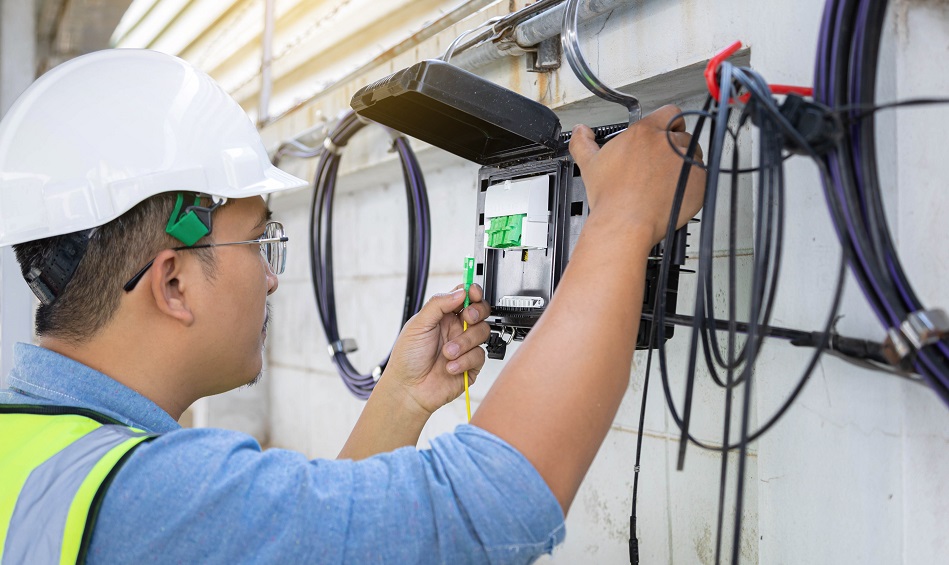
If a telecom enterprise wants to end the burgeoning digital divide (broadband access), then fixed wireless access is what you should be betting upon. The 5G fixed wireless access is being discussed as a potential game-changer for the 3GPP operators to serve the less fortunate households.
Contents
- 0.1 What is Fixed Wireless Access/ Fixed Wireless Internet (FWA)?
- 0.2 How does Fixed Wireless Access Work?
- 0.3 Benefits of Fixed Wireless Access
- 0.4 Key Challenges Faced by Fixed Wireless Access
- 0.5 5G with Fixed Wireless Access
- 0.6 Fixed Wireless Access Deployment
- 0.7 Is FWA an Alternative to Fibre, Cable and DSL?
- 0.8 What’s the Difference Between Fixed Wireless Connections and WiFi?
- 0.9 Can both technologies be used at home or the workplace?
- 0.10 Which one is better, DSL or Fixed Wireless Internet?
- 1 FAQs
What is Fixed Wireless Access/ Fixed Wireless Internet (FWA)?
FWA is not a nascent technology; it used to be referred to as radio local loop (RLL), wireless local loop (WLL) or wireless access local loopback in the day. Its application of personal communication systems and radio technology garnered much attraction from the developing economies across the globe in the early 2000s. The promise of FWA to deliver wireless broadband via radio links between two fixed points makes it a winner in rural or suburban areas where the deployment of fibre isn’t feasible for either poor technical or financial situations.
With the aftermath of the COVID-19 pandemic, smartphone usage behaviour and now, the rise in demand for ultra-high-speed broadband has exposed the connectivity infrastructure globally. But how can FWA solve the broadband access issue now when it has been in existence for decades now? Well, the emergence of 5G will make mobile technologies intersect with fixed-line services. Fortunately, the 5G Fixed Wireless Access (FWA) won’t require the new overlay infrastructure or expensive equipment as WiMax needed.
It can be deployed and sustained on the standard architectures of 3GPP. The expectations with 5G FWA are such; experts believe it can be a sustainable alternative for cable and fibre and fixed-line DSL. The introduction of 5G networks will help redirect houses with capacity improvement and by meeting the exponential demand of global mobile data traffic. Such initiations will aid service providers in establishing efficient network convergence with LTE and broadband networks. STL firmly believes that FWA can turn out to be a profitable growth opportunity by enabling the “Networks of Tomorrow.”

How does Fixed Wireless Access Work?
The FWA technology is set up via base stations which are already placed on the telecommunication poles. Depending upon the location, be it a house, building, indoors or outdoors, terminal antennas are placed at each site. The data is supposed to travel to a fibre backhaul tower over an existing hard-wired network and it now travels almost five miles over the air.
The end goal is to reach a particular home that is well equipped with a special receiver. As we know, data is relayed in cellular networks; here lies the same possibility as well. In many cases, data might travel even up to 50 miles from the host fibre network. Following this mechanism leads to the prevention of laying miles and miles of fibre.
The fixed wireless access system can be categorized into three classifications:
- Cellular grade systems are characterized by the use of air interfaces standardized for mobile technology applications.
- Wireline grade systems – Based on proprietary air interfaces. Such systems use higher bit-rate, toll-quality speech coding for fax and modem signals to pass in the speech band.
- Broadband FWA systems – It offers bit rates above primary rate access to every subscriber site.

Benefits of Fixed Wireless Access
The recent market disruption caused by the possible amalgamation of FWA and 5G has made the relevance of fixed wireless well known amongst the industry’s stakeholders.
- A credible alternative for copper networks – The supreme benefit of FWA technology is its potential to become an alternative for traditional copper networks, including distribution cables, feeder cables, splice boxes, and pedestals. Such an arrangement is a tedious affair from both, financial and operational standpoint. The estimates suggest 80% of maintenance expenditures are allocated for local access lines. The cost for FWA deployment can be characterized as “electronics.” If compared, electronic costs tend to decline faster than copper networks.
- A value proposition for both developed and developing markets – The wireless internet has a critical role in the scheme of high-speed internet access. FWA can address three different sections of the developed markets, namely, broadband connectivity in urban areas, fulfilment of rural demand where wireline infrastructure is a significant challenge, and lastly, the temporary demand in areas where temporary connectivity services are required, especially for events, festivals, concerts, etc. On the other hand, developing nations can be cured of the digital divide. The urban demand in developing markets is similar to the rural demand of the developed markets. And with FWA, they get to enjoy the high bandwidth instead of the ISDN (Integrated Service Digital Network) from the very first day.
- 5G FWA can ensure bandwidth capacity comparable to fibre optics – Using the lower bands of the wireless spectrum, 5G Fixed wireless access can be easily deployed at reasonable costs. It is the future alternative for wired broadband.
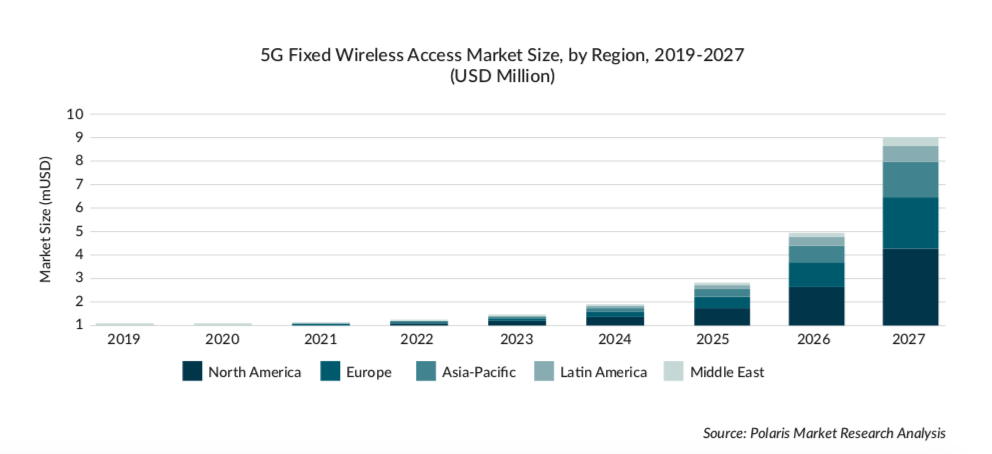
- Leverage for radio innovations – The case of FWA is supported by 3GPP radio access technology. FWA can help us leverage such radio innovations as – LTE air interface, advanced modulation schemes, carrier aggregation, and multi-antenna technologies. Additionally, wireless networks do not require as much power supply as mobile networks do. This gives a fair chance to optimize performance even further. Multi-antenna CPEs and high gain outdoor CPEs are also present as available options. Fixed wireless can have fibre-like performance with all such mechanisms in place.
Key Challenges Faced by Fixed Wireless Access
FWA also comes with certain practical and technical challenges apart from all its favourable benefits.
- The bullish requirements of the line of sight or near the line of sight between points can turn out to be taxing. A greater distance where the curvature of Earth might have significance can produce issues with the connectivity of positioning and altitude of devices. The fixed wireless solutions roughly have a range of 100 km which calls for multiple repeaters to reach the desired location. Any failures which occur between repeaters will compromise the resilience of the entire infrastructure.
- The predominant challenge with FWA persists within the spectrum being used. For FWA to deliver on its promises, it will have to meet the throughput demands and capacity as expected for FTTH-type services. The spectrum below 3GHz is limited, which puts mmWave (above 20 GHz) at the forefront for FWA solutions, which means new technology and tools would be required for the deployment. However, technical solutions such as beamforming have been promising so far.
- The high cost of customer premises equipment (CPE) is a notable barrier. The costs can come down once more manufacturers enter the marketplace.
- The mmWave might present issues from the penetration perspective. Some even fear that it can’t scale it beyond the small pockets of 5G hotspots in dense urban environments. And even with solutions at hand, you can’t be sure of an omnipresent coverage using mmWaves.
Interoperability and scalability have made mobile communications what they are today. The FWA needs the same pillars for it to become a worldwide success. For FWA’s scalability and interoperability, a technology standard will have to be designed and accepted by all the mobile operators. The compatibility with 3GPP-defined radio access will result in exponential growth and economies of scale for FWA.
5G with Fixed Wireless Access
The dominance of cable and DSL was bulletproof until 5G arrived and exposed the historical shortcomings. The mettle of 5G has made experts rethink FWA technology. The possibility of wireless broadband connectivity sounds like Beethoven to the global telecommunications community. It’s not as if the possibility wasn’t considered earlier, but the missing element was 5G. The ten times the lower latency rates along with ten times the bandwidth across many radio frequencies make 5G an excellent blend with FWA for wireless broadband solutions.
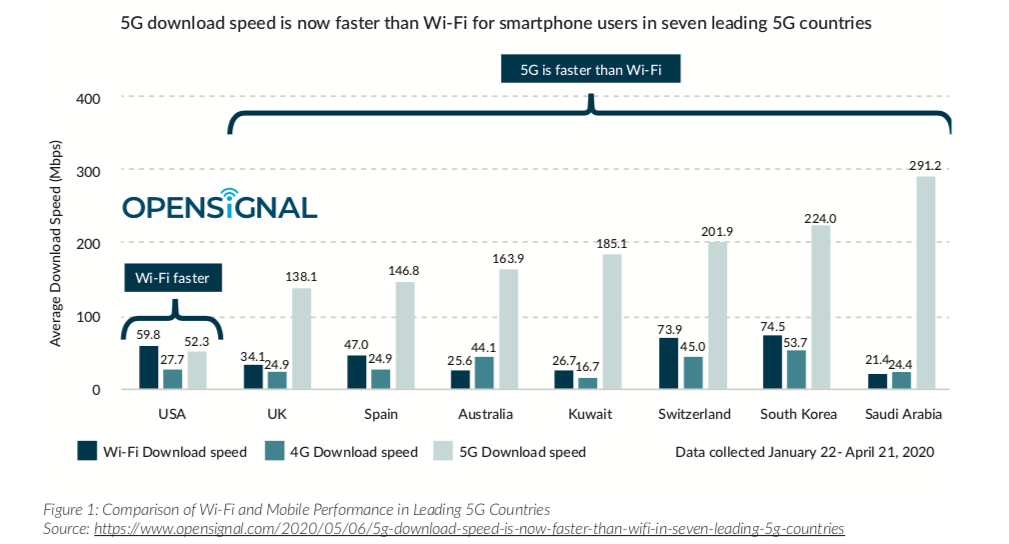
5G FWA is being awaited by the end consumer as well. A survey conducted in the U.K., USA, and South Korea of 3,000 people revealed that 76% of them believed that fixed wireless is an appealing 5G use case. Furthermore, 66% of participants also said they invest in 5G FWA subscriptions if the costs and performance are at par with the current options available in the market.
The partnership of FWA and 5G in supporting high peak rates without any dedicated facilities for every individual customer is immensely helpful. Both the technologies complement each other, and the primary reason is the low latency provided by 5G. So it is considered, latency has significantly dropped to 4 milliseconds due to 5G. That’s a massive drop from 4G’s 30 milliseconds.
Mobile Network Operators (MNOs) are looking at 5G FWA to solve two of their primary problems. Firstly, the eradication of FTTP connections in developed economies and a pathway for making a debut in the multi-play market. MNOs are looking to be a potential prospect for ultrafast broadband roll-outs. Despite expensive investments to be incurred, the optimism is driven by the opportunity of tapping into the multi-play market as there is no effective wholesale layer.
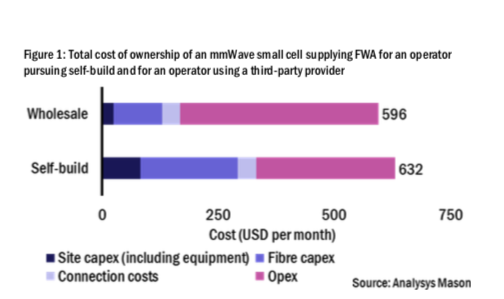
Fixed Wireless Access Deployment
The biggest advantage 5G can offer for FWA deployment is that it can put the lower bands of the spectrum to use. The global lobby has envisioned three frequency bands that can serve justice to the purpose of 5G technology. The aim should be to deliver assiduous coverage and throughput.
| Frequency | Coverage | Throughput | Suitability |
| 3.4-3.8 Ghz | Good | Good | This band can serve the low density rural and suburban areas. |
| 24.25-27.5 GHz | Poor | Excellent | This band can serve high-density suburban areas and cities. |
The Multiple Input Multiple Output (MIMO) antennas and new techniques such as beamforming can be used to optimize upload throughputs in the case of 5G FWA CPE. The biggest challenge with 5G FWA is the urban deployment. The connectivity to each antenna is an issue worth noting. The services based on mmWave 5G pose a concern for transporting fibre connectivity until the very last micro-cells.
However, microwave backhaul can resolve the issue as it uses the same mmWave 5G frequency. The goal is to have multiple connectivity pathways for the backhaul. This can be done by employing a mesh architecture. The same technology and spectrum are capable of ensuring the much-needed access and backhaul. The futuristic Integrated Access and Backhaul (IAB), which is part of the 3GPP release 16, can assist with multi-hop backhauling on the radio spectrum of mmWave 5G. With such a solution at disposal, FWA’s capability of ensuring competitive broadband will become a reality for both; residential and enterprise purposes.
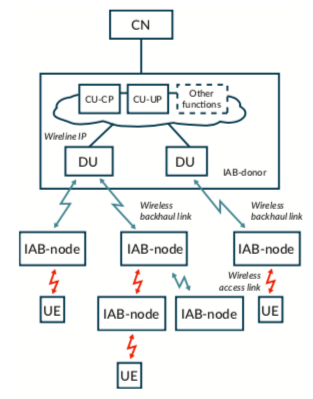
Is FWA an Alternative to Fibre, Cable and DSL?
All the technologies have challenges, but the COVID-19 pandemic has altered the demands of customers. People are now looking for or have shifted to options that are ultra-fast and reliable. Looking at the present circumstances, 5G wireless systems are the most desirable options for the customers in the coming time.
5G FWA’s potential of becoming a cost-effective alternative to fibre, cable, and DSL is a safe bet for the following reasons:
- The cost per delivered gigabyte can be optimized by acting on the opportunity of increased capacity catapulted by the greater spectrum allocations.
- The technological advancements of 5G mmWave have spurred the range of the spectrum up to a 7km radius which was earlier limited to a few hundred meters. Large-scale deployments of 5G fixed wireless access will be a possibility because of such extended ranges.
- Many tech giants, including Google and Facebook, are exploring wireless technologies because of the Extremely High Frequencies (EHF) 30 GHz and higher.
- Governments are FWA friendly as they want to fuel the growth of broadband connectivity for their digitalization goals.
As per Zion’s market research – the 5G FWA market will grow at a CAGR of 97.4% by 2025. The estimated market worth by 2025 is USD 23,291.5 million. With such astronomical figures, the case of 5G wireless technology looks more promising than ever.
What’s the Difference Between Fixed Wireless Connections and WiFi?
WiFi and fixed wireless connections are two separate technologies, but often users confuse the internet with WiFi and have little to no information about wireless connections.
| Particular | WiFi | Fixed Wireless Connections |
| Concept | It’s a technology that allows the transmission of data from a router to devices such as phones, and computers. | The internet service is delivered via radio signals to a fixed point. |
| Suitability | A common choice in the urban areas | It is also preferred in urban areas but serves a great purpose in rural areas where cable deployment isn’t feasible. |
| Connecting Source | It uses the ISP for connecting the devices for internet services | A nearby transmission tower along with a fixed line of sight is a must for it to operate efficiently |
| Speed | On average, 25 Mbps is considered a good speed | With 5G And FWA, the current capacity, operators can deliver 50 Mbps at peak speeds. |
| Safety | WiFi over the years has invited a fine share of criticism because of its safety concerns such as cyber-attacks, session hijacks, and more. | FW connections are much safer as it doesn’t require ISP as a source for providing data services. |
| Ease of Deployment | Technicians will have to install all the necessary equipment such as lines or cables. | Wireless operators are aiming at providing a hassle-free set-up which is conceivable with 5G FWA. Anybody could be able to set up the system without any technical assistance. |
Can both technologies be used at home or the workplace?
Yes, we can use both WiFi and fixed wireless under one roof.
The MNOs and industry leaders are now focusing on wireless FWA with the amalgamation of 5G technology. The partnership is considered healthy; operators get to grow their business, and consumers receive customer-centric services, which is far more than what they pay today.
Which one is better, DSL or Fixed Wireless Internet?
The FWA fixed wireless access vs the Digital Subscriber Line (DSL) is a debate worth having. DSL is essentially a typical broadband service that works on a telephone network. DSL isn’t successful without a telephone line and a modem. Weighing the pros and cons of both technologies can give us conclusive arguments.
| Fixed Wireless Access | DSL |
| The layout of reliable service at desirable speeds without any burdens of heavy deployment requirements | New versions of DSL are becoming faster but still are behind wireless internet solutions. |
| FWA services can be provided to the user by local businesses | DSL is offered typically by phone companies which means the user will have to necessarily subscribe for phone services as well |
| No data capping | Many DSL providers do practice data capping |
| Cost reduction for the end-user is still an ongoing battle | DSL is cost-effective at the moment if compared with FWA |
| The requirement of the user to be within 10 miles of the access point is a challenge. Although deploying repeaters will help, but any issues within the repeater will lead to chaos. | Proximity to the DSL’s main distribution point isn’t feasible for all users. |
DSL’s cost might be low compared with FWA, but the cost to benefit ratio in the case of wireless 5G FWA can’t be ignored either. With further improvements and advances in deployment, fixed wireless in the coming years will definitely unlock its potential for developing as big as the mobile communications market.
FAQs
What is fixed wireless internet access?
Fixed wireless connections aim at providing high-speed internet access via radio signals. Connections require the nearby transmission towers for operability. Consumers now prefer wireless technology because of no data capping restrictions. Rural areas are highly dependent on fixed wireless as deployment is hassle-free. It doesn’t require cables or fibre deployment, which makes it exclusive compared to other options available.
What is fixed wireless 5G?
Fixed wireless is not a new technology, but with 5G’s arrival, its potential can now be maximized. 5G FWA aims at providing ultra-fast internet/broadband services at ten times the lower latency rates and ten times the bandwidth across many radio frequencies in the coming future. Therefore, it is being considered as a viable alternative against cable and fibre options.
How fast is fixed wireless internet?
A traditional fixed wireless connection will range around 2-25Mbps. Still, with 5G fixed wireless, the range can go much higher, considering 5G is faster than the typical fibre networks. mmWave 5G devices can elevate the existing range by 30-40 times which would be remarkable.
Is fixed wireless the same as 5G?
No. The fixed wireless is a delivery mechanism for providing connectivity solutions to a user. In contrast, the 5G is the fifth generation of mobile networks, which is based on the cellular technology called the new radio (NR.) However, the amalgamation of the two is what makes it a double whammy. 5G FWA employs the standard 3GPP standardized architectures and holds the potential of delivering ultra-high-speed internet services, which might be the first of its kind.
What factors will influence my internet experience for fixed wireless?
A handful of factors can influence the internet experience on fixed wireless, but some of the most common ones are as follows:
- Distance from the transmission tower
- Physical blockages
- Quality of antenna deployment
- Signal reflection
- Network interference
- Total load and usage of the network














